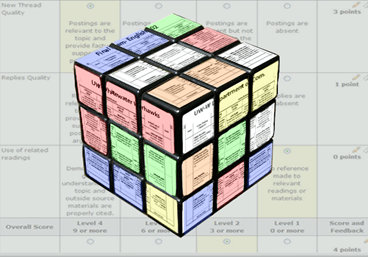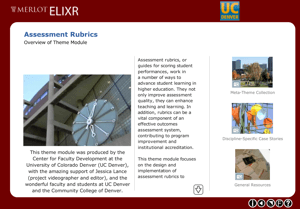Students, especially in online courses, want specific feedback on their assignments to understand why they received the grade assigned by an instructor and how they could improve.
There are a few different formats for communicating your expectations (e.g., articulating in detail as part of assignment instructions), but rubrics have become increasingly common in higher education. Rubrics provide clear criteria regarding what is expected for an assignment and guide specific feedback on why a certain grade has been given. Rubrics may also make it more efficient for faculty members to provide specific and detailed feedback.
"Every time I introduce rubrics to a group of teachers the reaction is the same: instant appeal ("Yes, this is what I need!"), followed closely by panic ("Good grief, how can I be expected to develop a rubric for everything?"). When you learn what rubrics do — and why — you can create and use them to support and assess student learning without losing your sanity." - Author Heidi Goodrich Andrade in her article Understanding Rubrics
Rubrics are particularly useful for problem-solving or application-based assessments because a rubric can list a different category for each component of the assessment that needs to be included, thereby accounting for the complexity of the task. For example, a rubric for a research paper could include categories for organization, writing, argument, sources cited, depth of content knowledge, and more. A rubric for a presentation could include categories related to style, organization, language, content, etc. Students benefit from receiving rubrics because they learn about their relative strengths and weaknesses.
Best Practices and Advice
 Consider rubrics for activities that make up a significant portion of the grade (e.g., summative assessments or shorter activities that provide opportunities for feedback that will improve students’ performance on summative assessments). A rubric is a detailed articulation of the criteria against which student work will be judged. Rubrics help students understand what is expected, how they will be assessed, and how to improve.
Consider rubrics for activities that make up a significant portion of the grade (e.g., summative assessments or shorter activities that provide opportunities for feedback that will improve students’ performance on summative assessments). A rubric is a detailed articulation of the criteria against which student work will be judged. Rubrics help students understand what is expected, how they will be assessed, and how to improve.
Rubrics...
-
List categories of performance to be assessed.
-
Describe levels of performance in each category.
-
Communicate criteria for developing, revising, and judging work.
-
Make criteria transparent for purposes of effective feedback and/or grading.
Why Use Rubrics?
Rubrics can help improve student performance by making an instructor's expectations clear and by showing students how to meet those expectations. The result is often marked improvements in the quality of student learning. Thus, the most common argument for using rubrics is that they help define "quality."
Rubrics also help students become more thoughtful judges of the quality of their own and others' work. When rubrics are used to guide self- and peer-assessment, students develop the ability to spot and solve problems in their work.
Rubrics that are completed with comments can provide students with more informative feedback about their strengths and areas to improve. They also add fairness to the assessment process, helping students to understand why they received a particular grade, score, or rating. Studies have found that students feel rubrics clarify expectations and are especially useful as they prepare assignments.
Rubrics take time to develop, but they make it easier to judge student work and provide feedback over the long-run. If developed well, they can reduce the amount of time evaluating student work.
Tip: Write feedback for each level of performance for a rubric in advance that can be pre-inserted in digital rubrics or pasted into a document version of a rubric. This feedback can be tailored to each student, if preferable, or linked to the assignment guidelines to provide more explanation of how to achieve the assignment.
University of Wisconsin–-Madison instructors discuss how they use rubrics:
- Mark Edgar, Senior Outreach Specialist, Population Health Sciences
- Jennifer Gipson, Professor of French, College of Letters and Science
- Evelyn Howell, Professor and Chair, Landscape Architecture
- Doug Hadley, Senior Lecturer, Landscape Architecture
-
Analytic Rubrics feature a grid of "criteria" (columns) and "levels" of achievement (rows). The instructor assigns points or weights to particular criteria, and then evaluates student performance in each area.
-
Holistic Rubrics describe characteristics of each level of performance for an assignment or activity (e.g., characteristics of an excellent research paper).
Analytic and Holistic Rubric Examples
-
academic discipline and teaching philosophy
-
course level and number of students
-
grading philosophy
-
Review the learning objectives. Identify what you want students to do or to accomplish as the learning outcomes.
-
List performance criteria. Develop a list of criteria that reflect the learning objectives and that describe the tasks, behaviors, or elements that students are expected to demonstrate in their product or performance. Tip: Review past examples of student work (e.g., "A" work and "D" work) to draft criteria and levels of performance.
-
Describe levels of quality. Describe the best and worst levels of quality for each criterion, and then fill in the middle levels to complete the range of performance levels. Tip: Consult existing literature, colleagues, and resources to identify existing rubrics. Adapt an existing rubric to match your specific goals, criteria, and assignment.
-
Develop a grid. Use a grid format with columns and rows, listing objectives or expected performance in the first column and descriptions of various levels of performance in the next columns.
-
Add a descriptor or numerical score to each performance level. Use a descriptive word to identify each performance level, such as "beginning, developing, accomplished, exemplary." If you want to score/grade the student's work, add a number or rating to each level.
-
Practice using the rubric. Before using formally, verify the rubric by using it to evaluate previous student work. Or practice with students to determine if the rubric is clear, accurate, and covers all potential performances. Ask for student feedback on the usefulness and fairness of the rubric. Tip: Consider involving students in developing or evaluating a rubric.
-
Share the rubric with students. Before students begin an assigned activity that will be assessed, share the rubric with them to clarify what is expected in their work.
-
Assess students' work. Use the rubric to guide you in assessing how well students performed, or their level of mastery, in doing the learning activity or assignment.
- Revise the rubric. Keep track of the strengths and weaknesses of the rubric as you use it to assess student work. Modify to build in detail and improve communication.
-
Use this template and guide to develop your rubric to correlate with your grading scheme.
-
WikiPODia on Rubrics provides a comprehensive explanation of rubrics along with many examples and resources.
- There are also a variety of grading scales you can use for rubrics, as shared by Brown University.
- Use this Rubric for Rubrics guide to evaluate rubrics. This rubric guide describes a well-written rubric, distinguishing between rubrics that meet, approach, or are below standards for selection of criteria, distinction between levels, and quality of writing. This rubric may be used to assess the quality of a rubric that you find or one that you or a colleague has developed to make it more effective to assess an assignment to tailor it to your needs.
-
Rcampus Rubric Gallery: See “Free Rubrics” for over 380,000 public rubrics by grade level, subject, and type. Use the rubric search tool to find rubrics with specific keywords or grade level.
-
Search for rubrics that we organized just for you using a social bookmarking tool called Diigo. Search by subject or type of rubric (e.g., rubrics AND case study, discussion, etc.).
There are two broad categories of rubrics:
Instructors develop their own approach to rubrics based on:
Steps to Creating and Using a Rubric
Recommended Resources to Create Effective Rubrics
Rubric Digital Case Studies
The digital case studies (also shown and linked on left) provide very useful information on the design and implementation of assessment rubrics. Check out the discipline-specific case stories.
Reference: The MERLOT ELIXR Initiative is a digital case story repository that hosts discipline-specific multimedia stories on important instructional topics.
Rubric Templates and Guides
Where to Find Rubrics Galore:
You do not need to develop rubrics from scratch. Many great rubrics have already been created and shared that you can modify for your needs. Here are a few places you can search for thousands of rubrics.
How did we do that?
Diigo (works best with Google Chrome) is a social bookmarking website that allows registered users to bookmark and tag web-pages. Additionally, it allows users to highlight any part of a web page and attach sticky notes to specific highlights or to a whole page.
